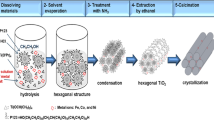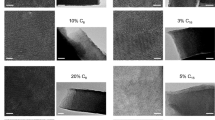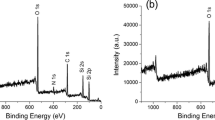Abstract
Mesoporous hybrid materials containing inorganic and organic functional groups are relevant for advanced applications in separation, sorption or heterogeneous catalysis. The possibility of combining materials with high surface area and tailorable mesopore size with a mixed oxide framework and organic functions open the gate to imitating complex biosystems such as enzyme active sites. One of the critical aspects towards a multiscale control of these complex materials is the understanding of the actual framework structure and the interplay of the framework ions and the organic functions, and how these features are related to the sol-gel preparation conditions. In this work, mesoporous hybrid organic-inorganic thin films (MHTF) based on a mixed silica-titania matrix containing 20% aminopropyl functions were prepared and thoroughly studied by X-ray absorption spectroscopy at both the Ti and Si K-edges, and by O1s and N1s X-ray photoelectron spectroscopy. This approach permitted us to simultaneously probe the changes in Si and Ti coordination, the linkages between the inorganic centers, and the availability of the amino functions along samples with varying Si:Ti ratio. We find substantial differences between the local structure of pure inorganic oxides and the hybrid materials. In the oxides, increasing the %Ti leads to an increase in octahedral Si sites and Ti-oxo clusters with shorter Ti-O bonds. In the hybrid materials, higher Ti coordination with longer bonds are observed, along with a prevalence of Si centers with distorted tetrahedral coordination. These findings suggest that aminopropyl building blocks act as a compatibilizer between Ti(IV) and Si(IV) centers, leading to a hybrid mixed phase with large silica-titania interface. This intermixing also influences the exposition of amino groups at the pore surface. These aspects are of importance in the design of high surface area adsorbents, permselective membranes or heterogeneous catalysts.

The structure of highly organized mesoporous thin films with aminopropyl groups and Si-Ti framework can be precisely determined by combining XANES and XPS. Functionality can be controlled from synthesis.
Highlights
-
Highly organized mesoporous thin films with aminopropyl groups and Si-Ti framework are synthesized from a one-pot, low-temperature method.
-
We present an exhaustive spectroscopic study of these materials by combining XANES and XPS.
-
Ti and Si K-Edge XANES permit to assess the changes in bonding and coordination of both cations in mixed oxide and hybrid matrices.
-
XPS measurements permit to understand the formation of Si-O-Ti interfaces and the availability of the amino groups.
-
This study permits to link sol-gel processing conditions to the structure of complex hybrid mesoporous materials.







Similar content being viewed by others
Data availability
Supplementary Data are available at the Publisher.
References
Kickelbick G (2007) Hybrid materials: synthesis, characterization, and applications. WILEY-VCH Verlag
Nicole L, Boissiere C, Grosso D et al. (2005) Mesostructured hybrid organic-inorganic thin films. J Mater Chem 15:3598–3627. https://doi.org/10.1039/B506072A
Sanchez C, Belleville P, Popall M, Nicole L (2011) Applications of advanced hybrid organic–inorganic nanomaterials: from laboratory to market. Chem Soc Rev 40:696–753. https://doi.org/10.1039/c0cs00136h
Faustini M, Nicole L, Ruiz-Hitzky E, Sanchez C (2018) History of organic–inorganic hybrid materials: prehistory, art, science, and advanced applications. Adv Funct Mater 28. https://doi.org/10.1002/adfm.201704158
Ruiz-Hitzky E, Wicklein B (2018) The fascinating world of the functional hybrid and biohybrid materials. Adv Funct Mater 28:1803407. https://doi.org/10.1002/adfm.201803407
Park SS, Ha C-S (2018) Hollow hybrid materials: hollow mesoporous functional hybrid materials: fascinating platforms for advanced applications. Adv Funct Mater 28:1870183. https://doi.org/10.1002/adfm.201870183
Margelefsky EL, Zeidan RK, Davis ME (2008) Cooperative catalysis by silica-supported organic functional groups. Chem Soc Rev 37:1118–1126. https://doi.org/10.1039/b710334b
Climent MJ, Corma A, Iborra S (2011) Heterogeneous catalysts for the one-pot synthesis of chemicals and fine chemicals. Chem Rev 111:1072–1133. https://doi.org/10.1021/cr1002084
Díaz U, Brunel D, Corma A (2013) Catalysis using multifunctional organosiliceous hybrid materials. Chem Soc Rev 42:4083–4097. https://doi.org/10.1039/c2cs35385g
Fernandes AE, Jonas AM (2019) Design and engineering of multifunctional silica-supported cooperative catalysts. Catal Today 334:173–186. https://doi.org/10.1016/j.cattod.2018.11.040
Notestein JM, Katz A (2006) Enhancing heterogeneous catalysis through cooperative hybrid organic-inorganic interfaces. Chem - A Eur J 12:3954–3965. https://doi.org/10.1002/chem.200501152
Motokura K, Tada M, Iwasawa Y (2007) Heterogeneous organic base-catalyzed reactions enhanced by acid supports. J Am Chem Soc 129:9540–9541. https://doi.org/10.1021/ja0704333
Motokura K, Tada M, Iwasawa Y (2008) Cooperative catalysis of primary and tertiary amines immobilized on oxide surfaces for one-pot C-C bond forming reactions. Angew Chem—Int Ed 47:9230–9235. https://doi.org/10.1002/anie.200802515
Motokura K, Tada M, Iwasawa Y (2009) Layered materials with coexisting acidic and basic sites for catalytic one-pot reaction sequences. J Am Chem Soc 131:7944–7945. https://doi.org/10.1021/ja9012003
Soler-Illia GJAA, Azzaroni O (2011) Multifunctional hybrids by combining ordered mesoporous materials and macromolecular building blocks. Chem Soc Rev 40:1107–1150. https://doi.org/10.1039/c0cs00208a
Innocenzi P, Malfatti L (2013) Mesoporous thin films: properties and applications. Chem Soc Rev 42:4198–4216. https://doi.org/10.1039/c3cs35377j
Lebeau B, Galarneau A, Linden M (2013) Introduction for 20 years of research on ordered mesoporous materials. Chem Soc Rev 42:3661–3662. https://doi.org/10.1039/c3cs90005c
Brilmayer R, Förster C, Zhao L, Andrieu-Brunsen A (2020) Recent trends in nanopore polymer functionalization. Curr Opin Biotechnol 63:200–209. https://doi.org/10.1016/j.copbio.2020.03.005
Soler-Illia GJAA, Innocenzi P (2006) Mesoporous hybrid thin films: the physics and chemistry beneath. Chem—Eur J 12. https://doi.org/10.1002/chem.200500801
Innocenzi P, Soler-Illia G (2009) Mesoporous thin films: an example of pore engineered material. Key Eng Mater 391:109–120. https://doi.org/10.4028/www.scientific.net/KEM.391.109
Soler-Illia GJAA, Vensaus P, Onna D (2021) Chemical methods to produce mesoporous thin films with tunable properties. In: Das S, Dhara S (eds) Chemical solution synthesis for materials design and thin film device applications. Elsevier, pp 195–229. https://doi.org/10.1016/B978-0-12-819718-9.00002-9
Nasir T, Herzog G, Hébrant M et al. (2018) Mesoporous silica thin films for improved electrochemical detection of paraquat. ACS Sens 3:484–493. https://doi.org/10.1021/acssensors.7b00920
Otal EH, Angelomé PC, Bilmes SA, Soler-Illia GJAA (2006) Functionalized mesoporous hybrid thin films as selective membranes. Adv Mater 18. https://doi.org/10.1002/adma.200502215
Alberti S, Soler-Illia GJAA, Azzaroni O (2015) Gated supramolecular chemistry in hybrid mesoporous silica nanoarchitectures: Controlled delivery and molecular transport in response to chemical, physical and biological stimuli. Chem Commun 51:6050–6075. https://doi.org/10.1039/c4cc10414e
Calvo A, Yameen B, Williams FJ, et al. (2009) Facile molecular design of hybrid functional assemblies with controllable transport properties: Mesoporous films meet polyelectrolyte brushes. Chem Commun. https://doi.org/10.1039/b822489g
Calvo A, Yameen B, Williams FJ et al. (2009) Mesoporous films and polymer brushes helping each other to modulate ionic transport in nanoconfined environments. An interesting example of synergism in functional hybrid assemblies. J Am Chem Soc 131:10866–10868. https://doi.org/10.1021/ja9031067
Silies L, Andrieu-Brunsen A (2018) Programming ionic pore accessibility in zwitterionic polymer modified nanopores. Langmuir 34:807–816. https://doi.org/10.1021/acs.langmuir.7b00529
Andrieu-Brunsen A, Micoureau S, Tagliazucchi M et al. (2015) Mesoporous hybrid thin film membranes with PMETAC@Silica architectures: controlling ionic gating through the tuning of polyelectrolyte density. Chem Mater 27:808–821. https://doi.org/10.1021/cm5037953
Rafti M, Brunsen A, Fuertes MC et al. (2013) Heterogeneous catalytic activity of platinum nanoparticles hosted in mesoporous silica thin films modified with polyelectrolyte brushes. ACS Appl Mater Interfaces 5:8833–8840. https://doi.org/10.1021/am403836f
Calvo A, Fuertes MC, Yameen B et al. (2010) Nanochemistry in confined environments: polyelectrolyte brush-assisted synthesis of gold nanoparticles inside ordered mesoporous thin films. Langmuir 26:5559–5567. https://doi.org/10.1021/la9038304
Yang Q, Li C (2014) Catalysis in porous-material-based nanoreactors: a bridge between homogeneous and heterogeneous catalysis. In: Can L, Yan L (eds) Bridging heterogeneous and homogeneous catalysis: concepts, strategies, and applications. WILEY-VCH Verlag, pp 351–396
Chandra P, Jonas AM, Fernandes AE (2018) Sequence and surface confinement direct cooperativity in catalytic precision oligomers. J Am Chem Soc 140:5179–5184. https://doi.org/10.1021/jacs.8b00872
Goettmann F, Sanchez C (2007) How does confinement affect the catalytic activity of mesoporous materials? J Mater Chem 17:24–30. https://doi.org/10.1039/b608748p
Calvo A, Angelomé PC, Sánchez VM et al. (2008) Mesoporous aminopropyl-functionalized hybrid thin films with modulable surface and environment-responsive behavior. Chem Mater 20:4661–4668. https://doi.org/10.1021/cm800597k
Puglisi A, Annunziata R, Benaglia M et al. (2009) Hybrid inorganic-organic materials carrying tertiary amine and thiourea residues tethered on mesoporous silica nanoparticles: synthesis, characterization, and co-operative catalysis. Adv Synth Catal 351:219–229. https://doi.org/10.1002/adsc.200800635
Brunelli NA, Venkatasubbaiah K, Jones CW (2012) Cooperative catalysis with acid-base bifunctional mesoporous silica: impact of grafting and Co-condensation synthesis methods on material structure and catalytic properties. Chem Mater 24:2433–2442. https://doi.org/10.1021/cm300753z
Lauwaert J, Moschetta EG, Van Der Voort P et al. (2015) Spatial arrangement and acid strength effects on acid-base cooperatively catalyzed aldol condensation on aminosilica materials. J Catal 325:19–25. https://doi.org/10.1016/j.jcat.2015.02.011
Manangon-Perugachi LE, Smeets V, Vivian A, et al. (2021) Mesoporous methyl-functionalized titanosilicate produced by aerosol process for the catalytic epoxidation of olefins. https://doi.org/10.3390/catal11020196
Bianconi A, Incoccia L, Stipcich S (1983) EXAFS and near edge structure. Springer-Verlag, Berlin
van Bokhoven JA, Lamberti C (2015) X-ray absorption and x-ray emission spectroscopy: theory and applications
Jiang N, Su D, Spence JCH (2007) Determination of Ti coordination from pre-edge peaks in Ti K -edge XANES. Phys Rev B - Condens Matter Mater Phys 76. https://doi.org/10.1103/PhysRevB.76.214117
Wu Z, Xian DC, Natoli CR et al. (2001) Symmetry dependence of X-ray absorption near-edge structure at the metal K edge of 3d transition metal compounds. Appl Phys Lett 79:1918–1920. https://doi.org/10.1063/1.1405149
Angelomé PC, Andrini L, Calvo ME et al. (2007) Mesoporous anatase TiO2 films: Use of Ti K XANES for the quantification of the nanocrystalline character and substrate effects in the photocatalysis behavior. J Phys Chem C 111:10886–10893. https://doi.org/10.1021/jp069020z
Andrini L, Angelomé PC, Soler-Illia GJAA, Requejo FG (2016) Understanding the Zr and Si interdispersion in Zr1-xSixO2 mesoporous thin films by using FTIR and XANES spectroscopy. Dalt Trans 45:9977–9987. https://doi.org/10.1039/c6dt00203j
Angelomé PC, Andrini L, Fuertes MC et al. (2010) Large-pore mesoporous titania-silica thin films (Ti1-xSixO2, 0.1 ≤ x ≤ 0.9) with highly interdispersed mixed oxide frameworks. Comptes Rendus Chim 13:256–269. https://doi.org/10.1016/j.crci.2009.07.001
Calvo A, Angelomé PC, Sánchez VM et al. (2008) Mesoporous aminopropyl-functionalized hybrid thin films with modulable surface and environment-responsive behavior. Chem Mater 20:4661–4668. https://doi.org/10.1021/cm800597k
Zhang JF, Wang ZM, Lyu YJ et al. (2019) Synergistic catalytic mechanism of acidic silanol and basic alkylamine bifunctional groups over SBA-15 Zeolite toward aldol condensation. J Phys Chem C 123:4903–4913. https://doi.org/10.1021/acs.jpcc.8b11941
Angelomé PC, Soler-Illia GJDAA (2005) Ordered mesoporous hybrid thin films with double organic functionality and mixed oxide framework. J Mater Chem 15:3903–3912. https://doi.org/10.1039/b506484h
Soler-Illia GJAA, Angelomé PC, Bozzano P (2004) Highly ordered hybrid mesoporous bifunctional thin films. Chem Commun 2854. https://doi.org/10.1039/b413260b
Cagnol F, Grosso D, Sanchez C (2004) A general one-pot process leading to highly functionalised ordered mesoporous silica films. Chem Commun 4:1742–1743. https://doi.org/10.1039/b403753g
Calvo A, Joselevich M, Soler-Illia GJAA, Williams FJ (2009) Chemical reactivity of amino-functionalized mesoporous silica thin films obtained by co-condensation and post-grafting routes. Microporous Mesoporous Mater 121:67–72. https://doi.org/10.1016/j.micromeso.2009.01.005
Durham PJ (1987) Theory of XANES. In: Koningsberger DC, Prins R (eds) X-ray absorption: principles, applications, techniques of EXAFS, SEXAFS. Wiley, New York, NY, p 53–84
Ressler T (1998) WinXAS: a program for X-ray absorption spectroscopy data analysis under MS-Windows. J Synchrotron Radiat 5:118–122. https://doi.org/10.1107/S0909049597019298
Soler-Illia GJAA, Crepaldi EL, Grosso D, et al. (2002) Structural control in self-standing mesostructured silica oriented membranes and xerogels. Chem Commun 2. https://doi.org/10.1039/b207595d
Tate MP, Urade VN, Kowalski JD et al. (2006) Simulation and interpretation of 2D diffraction patterns from self-assembled nanostructured films at arbitrary angles of incidence: from grazing incidence (above the critical angle) to transmission perpendicular to the substrate. J Phys Chem B 110:9882–9892. https://doi.org/10.1021/jp0566008
Soler-Illia GJAA, Crepaldi EL, Grosso D, Sanchez C (2004) Designed synthesis of large-pore mesoporous silica-zirconia thin films with high mixing degree and tunable cubic or 2B-hexagonal mesostructure. J Mater Chem 14:1879–1886. https://doi.org/10.1039/b316033e
De Groot F, Vankó G, Glatzel P (2009) The 1s X-ray absorption pre-edge structures in transition metal oxides. J Phys Condens Matter 21. https://doi.org/10.1088/0953-8984/21/10/104207
Yamamoto T (2008) Assignment of pre-edge peaks in K-edge x-ray absorption spectra of 3d transition metal compounds: electric dipole or quadrupole? X-Ray Spectrom 37:572–584. https://doi.org/10.1002/xrs.1103
Farges F, Brown GE, Navrotsky A et al. (1996) Coordination chemistry of Ti(IV) in silicate glasses and melts: II. Glasses at ambient temperature and pressure. Geochim Cosmochim Acta 60:3039–3053. https://doi.org/10.1016/0016-7037(96)00145-7
Farges F, Brown GE (1997) Ti-edge XANES studies of Ti coordination and disorder in oxide compounds: comparison between theory and experiment. Phys Rev B—Condens Matter Mater Phys 56:1809–1819. https://doi.org/10.1103/PhysRevB.56.1809
Bianconi A, Dell’Ariccia M, Gargano A, Natoli CR (1983) Bond length determination using XANES. In: Bianconi A, Incoccia L, Stipcich S (eds) EXAFS and near edge structure. Springer-Verlag, Berlin, p 57–61
Piancastelli MN (1999) The neverending story of shape resonances. J Electron Spectros Relat Phenom 100:167–190. https://doi.org/10.1016/s0368-2048(99)00046-8
Howard CJ, Sabine TM, Dickson F (1991) Structural and thermal parameters for rutile and anatase. Acta Crystallogr Sect B 47:462–468. https://doi.org/10.1107/S010876819100335X
Iwamoto S, Iwamoto S, Inoue M et al. (2005) XANES and XPS study of silica-modified titanias prepared by the glycothermal method. Chem Mater 17:650–655. https://doi.org/10.1021/cm040045p
Ondračka P, Nečas D, Carette M, et al. (2020) Unravelling local environments in mixed TiO2–SiO2 thin films by XPS and ab initio calculations. Appl Surf Sci 510. https://doi.org/10.1016/j.apsusc.2019.145056
Permpoon S, Berthomé G, Baroux B et al. (2006) Natural superhydrophilicity of sol-gel derived SiO2-TiO2 composite films. J Mater Sci 41:7650–7662. https://doi.org/10.1007/s10853-006-0858-1
Levelut C, Cabaret D, Benoit M et al. (2001) Multiple scattering calculations of the XANES Si K-edge in amorphous silica. J Non Cryst Solids 293–295:100–104. https://doi.org/10.1016/S0022-3093(01)00658-5
Sutherland DGJ, Kasrai M, Bancroft GM et al. (1993) Si L- and K-edge x-ray-absorption near-edge spectroscopy of gas-phase Si(CH3)x(OCH3)4-x: models for solid-state analogs. Phys Rev B 48:14989–15001. https://doi.org/10.1103/PhysRevB.48.14989
Li D, Bancroft GM, Kasrai M et al. (1994) X-ray absorption spectroscopy of silicon dioxide (SiO2) polymorphs: the structural characterization of opal. Am Miner 79:622–632
Chaboy J, Barranco A, Yanguas-Gil A et al. (2007) Si K -edge XANES study of SiOxCyHz amorphous polymeric materials. Phys Rev B - Condens Matter Mater Phys 75:075205. https://doi.org/10.1103/PhysRevB.75.075205
Ohnemus DC, Krause JW, Brzezinski MA et al. (2018) The chemical form of silicon in marine Synechococcus. Mar Chem 206:44–51. https://doi.org/10.1016/j.marchem.2018.08.004
Crepaldi EL, Soler-Illia GJAA, Grosso D et al. (2003) Controlled formation of highly organized mesoporous titania thin films: from mesostructured hybrids to mesoporous nanoanatase TiO2. J Am Chem Soc 125:9770–9786. https://doi.org/10.1021/ja030070g
Tang Q, Angelomé PC, Soler-Illia GJAA, Müller M (2017) Formation of ordered mesostructured TiO2 thin films: a soft coarse-grained simulation study. Phys Chem Chem Phys 19:28249–28262. https://doi.org/10.1039/c7cp05304e
Jolivet J-P (2000) Metal oxide chemistry and synthesis: from solution to solid state. J. Wiley and Sons, Chichester
George I, Viel P, Bureau C et al. (1996) Study of the silicon/γ-APS/pyralin assembly interfaces by X-ray photoelectron spectroscopy. Surf Interface Anal 24:774–780. https://doi.org/10.1002/(SICI)1096-9918(199610)24:11<774::AID-SIA180>3.0.CO;2-X
Acknowledgements
This work was funded by CONICET (PIP No. 112-201101-01035) and ANPCyT (PICT 2017-4651, PICT 2017-1220, PICT 2018-04236, PICT 2018-03276). Synchrotron measurements were possible thanks to funding from LNLS, Campinas, Brazil: 2D SAXS (line D11A-SAXS1 Project Nos. 5867/06 and 6721/07) and XANES (line D04A-SXS Project Nos. 10808/11 and 15187/13).
Author information
Authors and Affiliations
Corresponding authors
Ethics declarations
Conflict of interest
The authors declare no competing interests.
Additional information
Publisher’s note Springer Nature remains neutral with regard to jurisdictional claims in published maps and institutional affiliations.
Supplementary information
Rights and permissions
About this article
Cite this article
Calvo, A., Andrini, L., Williams, F.J. et al. Controlling the local-ensemble structure in mesoporous hybrid titania-silica thin films containing aminopropyl groups. J Sol-Gel Sci Technol 102, 172–184 (2022). https://doi.org/10.1007/s10971-021-05579-x
Received:
Accepted:
Published:
Issue Date:
DOI: https://doi.org/10.1007/s10971-021-05579-x




